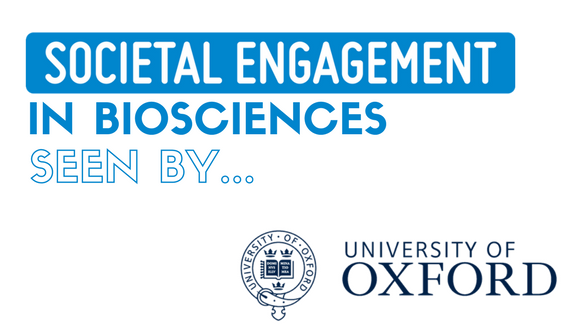
Dr. Laurel Edmunds – is a Senior Research Fellow working in collaboration with the NIHR Oxford BRC and relevant researchers across the University of Oxford. She is currently leading on a series of systematic reviews evaluating women in academic medicine and research efficacy in the NIHR Oxford BRC.
Dr. Maria Milano – is a research assistant at the Radcliffe Department of Medicine in Oxford University.
1. How do you understand “Societal Engagement” in biosciences research?
Societal engagement is a two-way process resulting from the interaction between researchers and the public in order to obtain a mutual benefit. It is signified through different types of activities:
- collaborating activities which aim to create or decide something together with the public (e.g. partnership working);
- receiving activities where the views, knowledge and experiences of the public are used to inform, build, or even change decisions (e.g. surveys);
- transmitting activities with the intention of inspiring and informing the public (e.g. science festivals).
2. What are the current standards and actions to achieve better Societal Engagement in Oxford University and in England in general?
A key focus of the University of Oxford is to equip academics and researchers across the entire institution to develop and deliver public engagement with research activities. We have specially trained personnel that run courses and offer resourses (eg www.oxfordsparks.ox.ac.uk) to support researchers with their engagement activities. Societal engagement is now recognised as an academic accomplishment in the UK as part of the Research Excellence Framework (a rank of effectiveness and achievement of the UK researchers, by institution). Also, many funders require plans for it in their grant proposals. To foster a culture further, the University appointed a Pro-Vice-Chancellor for research and innovation strategies and policies who leads the public engagement efforts, and there is a Vice Chancellor‘s award for public engagement. Societal engagement has been championed in the UK since 2008, and Oxford is one of 28 universities that has special catalyst status.
This also applies to the Oxford BRC, thus the events and marketing department works in two main areas: societal engagement itself, in collaboration with researchers across the Oxford BRC, hosting many different events, and the public and patient involvement (PPI). PPI is also a major concern of the National Health Service (NHS) as they want to improve services to the public.
3. What are you aiming for with the implementation of the STARBIOS2 actions towards better Societal Engagement for the Medical Sciences Divison at the University of Oxford?
Because so much work has been done with PPI and continues to be expanded by leaders in the Oxford BRC, we are focusing on the societal engagement aspect of the Oxford BRC’s work. Our aim is to assess what is best practice so that we can help inform the strategies and actions of the Oxford BRC and to share this with other members of the consortium. We have collated a number of resources and tools that have been made available to UK researchers by the National Co-ordinating Centre for Public Engagement (NCCPE: www.publicengagement.ac.uk). Our original plan included a review of societal engagement interventions that had been evaluated but in the process of doing this, we found most information about what had been done in the UK. Consequently, we are now focussing on what the Oxford BRC do, what they find effective, and how we can help them make it better. In this way, we can support the policies and strategies within the Oxford BRC.
4. What kind of actions are you going to establish to fulfill your objectives?
We started off by doing an extensive search of publications and have scoped the NCCPE for work that has already been evaluated and reported upon. We have recently found a comprehensive review in this area published earlier this year, and so our review may not be necessary.
We also scoped the Oxford BRC societal engagement practices and their strategies with the help of the Oxford BRC Events and Marketing Manager, Cora Reilly McGeown. They organise many events every year. For instance, last year they organised the Oxford BRC Open day where hundreds of people visited John Radcliffe Hospital and had contact with the biomedical research taking place in Oxford. They also arranged a free public performance called ‘People are messy’ that explores the complexity of patient and public involvement.
In addition, the relationship between the Technology and Transfer Office (TTO) of the University of Oxford Innovation and societal engagement will be explored as the TTO works closely to the Oxford BRC.

Different events that took place at Oxford University
5. Who is involved, from Oxford University, in the action plan, in order to complete your final objective?
We (Laurel Edmunds and Maria Julia Milano) are working together in the Medical Science Division from the Radcliffe Department of Medicine of the University of oxford.
We also work with the Head of Operations of the Oxford BRC, Vasiliki Kiparoglou; the Clinical Research Manager of the Oxford BRC, Lorna Henderson; the Events and Marketing Manager of the Oxford BRC, Cora Reilly McGeown; and the Communication Department of the Oxford BRC. We are also in close collaboration with the personnel in the Medical Science Division and the University in general who has responsability for the public engagement with access to their expertise and their resources.







